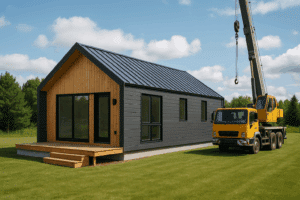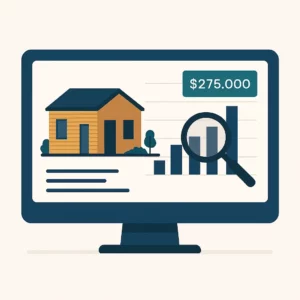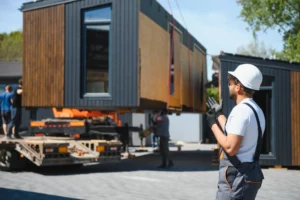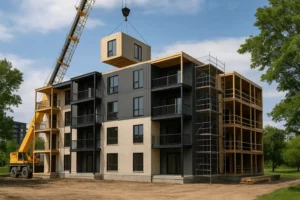Building in remote areas can be challenging. Labor costs, deadlines, and harsh weather conditions can quickly increase budgets.
This is where prefabricated homes offer a cost-effective solution. Manufactured in a factory, they reduce costs, speed up the construction process, and overcome logistical challenges, while offering customized options tailored to your land.
Discover the prefabricated house models available in remote areas on our platform : Check out our models.
The advantages of prefabricated homes in remote areas
Prefabricated homes are an ideal solution to overcome the many challenges associated with construction in remote areas.
Choosing a prefabricated home avoids several common obstacles, such as high labor costs and logistical costs often exacerbated by remote locations.
Here are some reasons why these homes are particularly advantageous in these areas:
- Reduction of labor costs
In remote areas, it is often difficult to find skilled local labor. Hiring workers from larger cities incurs additional costs, including travel, accommodation, and meals. Prefabricated homes overcome this problem by moving the bulk of the construction work to a factory, where the modules are assembled under optimized conditions. This not only reduces labor costs but also reduces construction time on site.
- Simplified and efficient transport
Transporting all the building materials to remote locations can be a real logistical headache. With prefabricated homes, the modules or sections of the house are transported all at once, limiting the number of trips required. This type of transport is often more economical because it requires less management and coordination than a traditional construction site. In addition, the modules are designed for easy assembly, reducing the time and costs associated with on-site assembly.
- Fast construction and less prone to delays
Weather can be a significant factor in remote areas, often delaying traditional construction. In contrast, prefabricated modules are manufactured in a controlled environment, protected from the elements. This not only ensures higher build quality but also shorter lead times, as the outdoor construction site is reduced to a simple assembly phase. This minimizes the risk of delays due to weather or site access difficulties.
- Quality controlled and customizable
Even in remote areas, it's possible to have a prefabricated home that meets your exact expectations. Prefabricated homes are not "off-the-shelf" constructions and can be adapted to the needs of the terrain and climate. You can choose specific materials, opt for sustainable energy solutions, and adapt the plans to your tastes. Construction quality is also closely monitored in the factory, ensuring a solid and durable structure, despite the region's natural challenges.
- Reduced environmental impact
Finally, prefabricated construction produces less waste, as everything is meticulously planned and optimized in the factory. Transporting complete modules also reduces the carbon footprint, as fewer trips are required to bring in materials. For remote areas, often close to nature, this aspect is particularly attractive for those looking to minimize their environmental impact.
In summary, prefabricated houses are an ideal solution for construction in remote areas, both for their economic advantages and for their speed and low ecological impact.
Interested in exploring the models available for your remote project? Discover our options on our platform: Check out our models.
Local regulations and building permits
Building in a remote area can involve specific regulations, particularly regarding building permits and access to essential services like water and electricity. Prefabricated homes often simplify these procedures because they comply with current standards from the outset, making it easier to obtain the necessary permits.
Technical challenges in remote areas
Remote sites often present technical challenges, such as limited access, difficult soils, or steep slopes. Prefabricated homes allow for these constraints to be anticipated, thanks to precise planning and construction adapted to the terrain's characteristics, ensuring a smooth installation.
After-sales service logistics
Once installed, maintenance and repairs can be more complicated in remote areas. However, prefabricated home manufacturers often offer reliable after-sales services, including remote maintenance and monitoring solutions, ensuring a trouble-free lifespan for these buildings.
Conclusion
Building in remote areas may seem like an insurmountable challenge, but prefabricated homes offer a practical, efficient, and economical solution. Thanks to simplified logistics, adaptation to local conditions, and eco-friendly options, they overcome the typical obstacles of these projects.
By choosing a prefabricated home, you benefit from fast, high-quality construction while controlling costs. Ready to make your project a reality in a remote area? Discover our models and find the ideal home on our platform : Check out our models.




